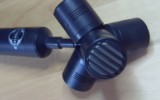
I now have 4 channels/sets of these, 3 of them with normal lav-mic Tx and 1 plug-on xlr Tx, and so far i’m happy with the transmission range; over 100m with no breakup/through, testing on an airfield at a busy event with plenty of RF flying around ( no pun intended )
The supplied mic capsules are, inevitably, not high-end devices, and sadly not one of the ‘standard’ Sony ECMs, so i’ve bought 2x Sanken COS11s to use with them so far, pretty much the ‘default’ lav of choice nowadays, but there’s nothing wrong with the supplied capsules for general interview use per se that i can see/hear, so they’re certainly worth taking along for ‘emergency’ use.
The Plug-on XLR Transmitter has Phantom power, unlike the offering from Sennheiser in the same price range.
I haven’t tested the range on the plug-on TX, which may be different to the bodypack one ( for one thing it doesn’t have an external ‘whip’ aerial ), but then it’s unlikely i’d expect the same range out of this device anyway, as my intention is to either use this for a ‘radio boom’ in conjunction with my second (mono) gun mic and Rycote mount, or as the tx for a mono feed to camera and/or monitoring.
The auto-scan procedure on the receiver to find a free channel, and the infra-red ‘relaying’ of that Freq. to the transmitter that’s paired with it work simply and perfectly. Very handy, although i realise this is a common enough feature on most or all recently produced radiomic models.
The other thing that sets this apart from the previous similar-looking Sony models, is the ‘Hybrid Digital’ signal path. The best way i can describe this is that instead of the usual ‘compansion’ circuits all radiomics use to increase the usable dynamic range over the RF link, these Sonys use a digital compressor and digital expander – in TX and RX units respectively – to act on the audio, which still however stays analog for its journey between the units. The idea is that this allows faster-responding compansion which lets through HF transients better and reduces ‘pumping’.
‘Helpfully’ Sony give you the option of switching back to the old analogue compansion, which is to allow a ‘mix and match’ with units from the previous UWP series, but it happens to also allow direct comparison between analogue and digital companders. I haven’t been able to do a critical test of the 2 modes yet, but when i do i’ll give my opinion here.
Speaking as an engineer, this should in theory make an improvement possible, but i wonder what the point is of including the circuitry to convert the audio to/from digital in both units ( twice in each as it happens ), and not just then be done with it and transmit it Digitally anyway. Or at least allow the option of cutting out a d-a stage at the rx end by providing digital outs…
The cynics answer to that might be that then they couldn’t ask £3k a pop for their ‘full’ digital radiomic channels, but that’s not really an answer, since in fact this ‘hybrid’ method does mean that you have some latency/delay in there that a purely analogue system wouldn’t have, without giving the benefit of clarity that a fully digital channel would have ( to more than compensate for the digital delay.)
In any case, if you set a tx and rx pair to the same Freq but then switch the TX to analogue compansion, you get a message on the RX ‘no tone’, which to me ( again as engineer ) suggests that the digital compansion system uses some kind of pilot-tone system to ‘track’ the expander to the compressor, in a similar way to the old ‘Sound-in-Syncs’ system at the BBC.
If that’s what it’s doing then the transient response should be pretty accurate, it just further makes me think that there is a lot of circuitry being designed and put into a small unit to AVOID just doing it digitally all the way through ( which potentially would be a LESS complex circuit at both ends, imho …)
Again, this is not my last word on this. Running report ( and more pics ) to follow….
The one aspect of construction that worries me is the aerial on the bodypack TX. This doesn’t appear to be user-removable for easy (in-field) replacement, and doesn’t inspire confidence that it will survive being repeatedly stressed/bent in typical use either :-/
Using these in Italy ( Rome ) i was worried that i wouldn’t find clear channels but i had no problems on 2 consecutive days in summer. I did opt for the version that covers both ch38 for the UK and the other channels that are allowed/preferred in Italy, but there was a chance both might be busy.








